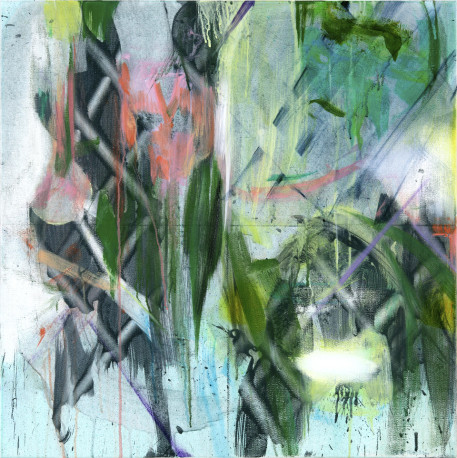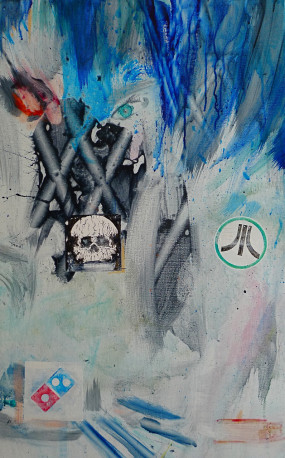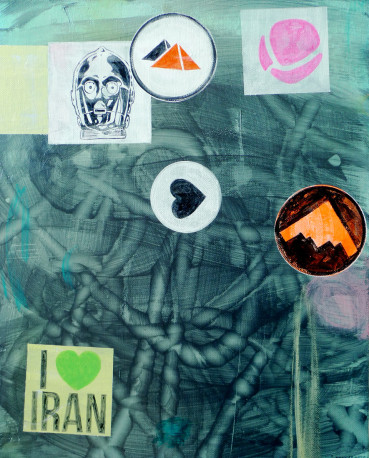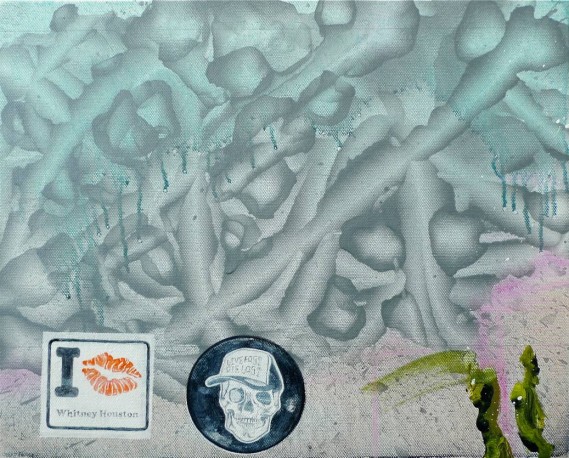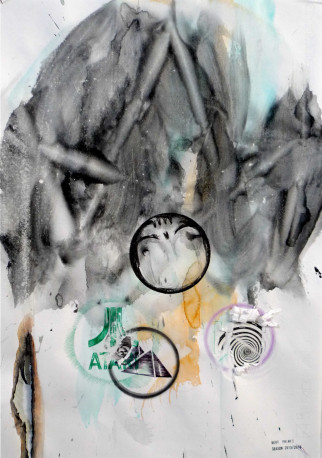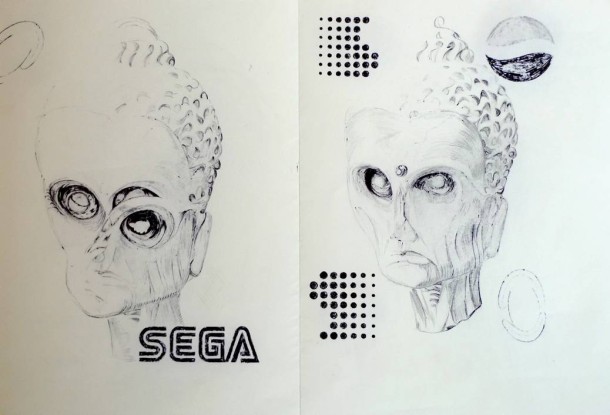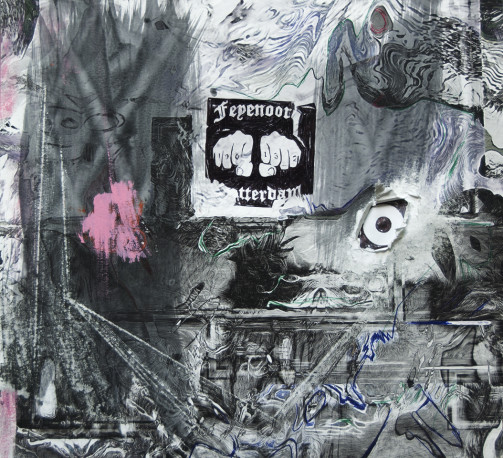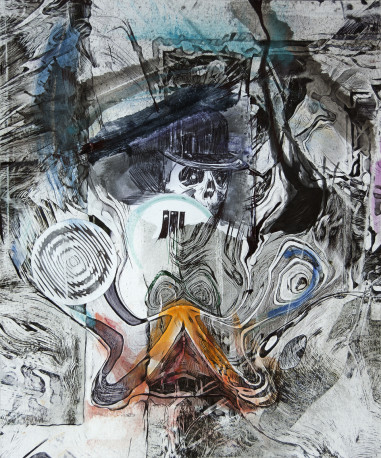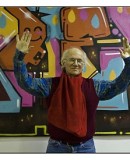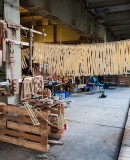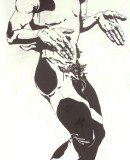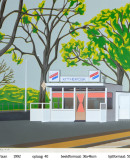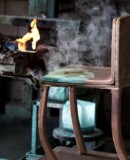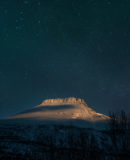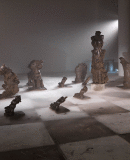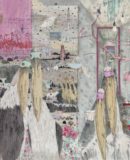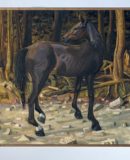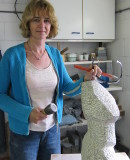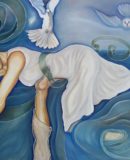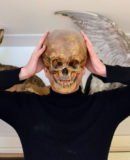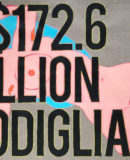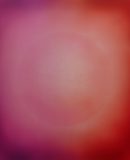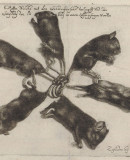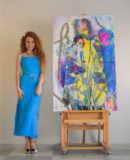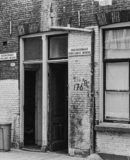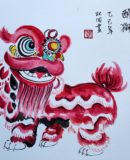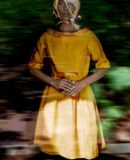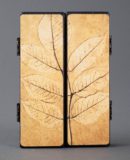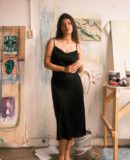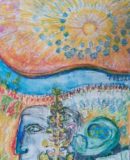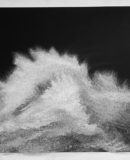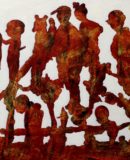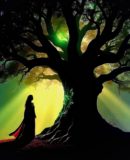World Fine Art Professionals and their Key-Pieces, 79 - Bert Frings
World Fine Art Professionals and their Key-Pieces, 79 – Bert Frings
The studio of Bert Frings is located in an old school in het Ruilstraat (Exchange Street). A beautiful street name. The owner of a couple of houses elsewhere in the city of Rotterdam left his residencies to put houses in this street, hence the name. There are more artists in the building.
Bert has a spacious place. On the left is a large table full of cans and tubes, in front of us hang paintings and right are recent paper works. For some of the windows depends black plastic. Sometimes he covers up all the windows with it to properly perform specific tasks.
Predator
We look closely at the Predator painting that hangs in front of us. A big work with light blue, pale gray and pink colors. Bottom left, top left and right there is a kind of lattice of crossed tubular fatty streaks. Stickers at some places, including a logo of Atari, a black heart, a logo of a pizza company, a mask. Middle left you see the outline of a skull. All this is a landscape, which looks a bit like science fiction.
Bert Frings: “There is a big role for the spectator, in all my works. Thoughts can come up and the spectator can finish the landscape, in his or her mind.” The painting is constructed in several layers. It started with shades of light blue and then the other shades. “My use of color is rather dirty.” The various lattices are airbrush made, leaving blank streaks in the paint. The stickers aren’t stuck, but also painted.
Frings is fascinated by paint and how you can let paint, as it were, ‘perform’. Light, thin, mushy, viscous. Using unusual tools as a window washer, a wiper, spray, sponge and airbrush. He discovered it by accident. “The tubular streaks, which I make with airbrush, initially seemed a mistake that should be corrected. On closer inspection it turned out to be a godsend, a gift, that I acquired while painting.”
And also the stickers that you see returning started to play an important role while working and trying. “Those stickers I saw on the street. I realized that I could use it. It adds extra meaning to the work, they are expressions of our time. On one of the stickers there is a collapsing temple. That sticker appeared a few years ago on the occasion of ‘Occupy Boymans’ and ‘The March of Civilization’ which came up after the cutting of cultural subsidies.”
Popcorn movies
Predator is also the title of an American science fiction film directed by John McTiernan, starring Arnold Schwarzenegger. Bert saw many of these films in his youth, in the ‘80s. “I witnessed the rise of the video store, and also I saw in the cinema, in Kerkrade and Heerlen, many ‘popcorn movies’, ‘Alien’, and ‘Blade Runner’ by Ridley Scott, ‘Star Wars’, ‘E.T.’ and ‘The Terminator’ by James Cameron.
To the left of The Predator hangs ‘The Broken Ear’, inspired by a work of the German expressionist Emil Nolde. He shows me the original work of Nolde, a still life with masks. “I had to think of the Hergé album, ‘The Broken Ear’, in which Tintin is amidst the indigenous people of the Arumbaya’s, a fictitious name as often was the case with Hergé. He also invented a Arumbaya language which was based on his childhood memories of Flemish as they speak it in Brussels.”
In addition to science fiction films ethnography is another source of inspiration. “The makers of science fiction films have drawn eagerly on this.” Through films Bert discovered the Tatanua masks, used at the Malagan ritual in New Ireland, an island above New Guinea in the Pacific. He shows me a book about the masks and other artworks. The Malagan ritual uses materials which were available: wood, plants, shells. They were processed into enigmatic spiritual images. In Frings’ work you see repeatedly masks.
Impermanence
“Fantasy is not infinite. There is a lot of copying. Everything is already there and everything is already done. That is the premise of postmodernism. But I do not belong to that movement. I still want to give an interpretation, in my own way. In art history, you can find a line and judge whether something is good. The ancient Egyptian name for a sculptor meant literally ‘he who keeps alive’. It is a consolation that someone’s work and ideas matter, even after one’s life.”
From Giotto, the artist was seen as an individual talent. Previously, he was as a person unimportant. Since then a rich art tradition has built up in which good quality always rises to the top. Look at what Vermeer and Mondrian have in common. A red thread, where you can measure yourself.”
Impermanence, vanitas, transcience, mortality, finitude, that is the key to his work, he says. “Life, death, everything and nothing, melancholy. Art is man-made and man is mortal. If there is a central theme, it is this. The fascination with death, especially not understanding it.”
The year 2015, Bert Frings did a lot of drawing. He made the drawing Pizzaboy. “Drawing is a great contrast to the painting. You get nothing for free. It is very vulnerable. With paper you can do more. You use the possibilities of the material. You look how far you can go.”He tears the paper and then pastes again, he rubs and he burns, or at least it seems that he has lit it, but it turns out to be paint.
And he makes paper sculptures. There are a few. One shows a mask a la the Tatanua mask. And here again a sticker, this time with the portrait of Whitney Houston. Behind another paper sculpture a skull is drawn, inspired by ‘The Pedlar’ by Hieronymous Bosch. Not the very well known pedlar from Boymans Museum, but a pedlar on the tryptych of The Last Judgment that hangs in Vienna.
J&B
Bert also works with another artist, Jacob.Gd. Jacob is enormously imaginative and makes ingenious drawings with the computer. Some of them he sends to Bert who continues working on it in his way. He opens a folder and shows a number of drawings. He rubs, he makes it flatter, he discolors etcetera. The plan is to organize a joint exhibition at Gallery Zerp. The collaboration has also meant that Bert is thinking about doing more with the computer himself.
The cooperation with Jacob is about more than just drawings, it results also in sculptural work. They share a common interest for the immediate surroundings, such as the street. What stands out? Garbage, plastic, materials that express decay and desolation. “As David Hammons showed in Venice, not at the Biennale itself, but at Punta della Dogana, in an exhibition composed by Danh Vo. He was very inventive with agricultural plastic. It seemed like painting, but it was not painting. Hammons has a lot of work with what he has gathered on the street. Some works nowadays bring at an auction the amount of two million dollars.”
Han Leblanc
Bert Frings was always making drawings, but his interest in art was truly awakened by his art teacher in high school, Han Leblanc. Every year he was taught by him until the final exam. “He was very serious about the subject. He had contact with artists around the world. He organized excursions to museums that were relatively close, as Düsseldorf and Cologne, but also Paris once.”
In the German museums he saw contemporary art, but also work by Kirchner, Heckel and Nolde. “Representatives of expressionism, which in turn was inspired by ‘primitive’ non-western art. It was a lively time, the 80s. It was also quite clear when you compare it with the present time, where there is continuing doubt on truth and authenticity.”
After high school Frings went to the Rietveld Academy in Amsterdam. “It was not quite what I expected, very scholastic. After a while I started painting myself, apart from the Academy and was admitted with that work at De Ateliers in Amsterdam. That was great, as I expected. You could start researching and experimenting yourself and there were good coaches like Rob Birza, Marien Schouten and Rita McBride. I learned a lot. We as students also had a lot of contact. My neighbor was Shah Jahan, he was originally from Sylhet, Bangladesh, but moved to England at an early age. We did a lot together. He made very own work and loved Michael Jackson. Unfortunately he is deceased young.”
Gifts
Once independent artist life proceeded in waves. “Sometimes there was a lot of attention to my work and good sales. At other times it was less. I taught and I also received several stipendia, so I could continue. You really have to live a disciplined life and work hard. Compare it with the life of a professional athlete. Sometimes I feel a survival artist, then I think of the verdict of Jan Cremer “If I am missing out the million, I’ll buy a bag of chips and a croquette.’”
Asked about his philosophy, he cites Marcel Duchamp ‘Art is something that happens between the idea and the realization of the idea’. “That is very cunning, how far do you go in the elaboration of the idea? Freedom of choice, inventiveness, being proactive, taking initiative is important, I think. Success is not necessarily guaranteed. I experienced that as you keep trying to shift boundaries, you make mistakes, but some of those mistakes prove in retrospect no mistakes, but are just great ‘gifts’.”
From May 5th till June 20th Bert Frings has an exhibition in Barcelona, together with the artist Jacob, also from Rotterdam.
They present their common work as B&J in Ei! Espai d’Impulsió, Torrent de L’Olla, 6, Barcelona
http://www.bertfrings.nl/HOME_.html
http://ifthenisnow.eu/nl/verhalen/de-wereld-van-de-rotterdamse-kunstenaar-14-bert-frings
Disclaimer: The views, opinions and positions expressed within this guest article are those of the author Walter van Teeffelen alone and do not represent those of the Marbella Marbella website. The accuracy, completeness and validity of any statements made within this article are not guaranteed. We accept no liability for any errors, omissions or representations. The copyright of this content belongs to Walter van Teeffelen and any liability with regards to infringement of intellectual property rights remains with the author.


